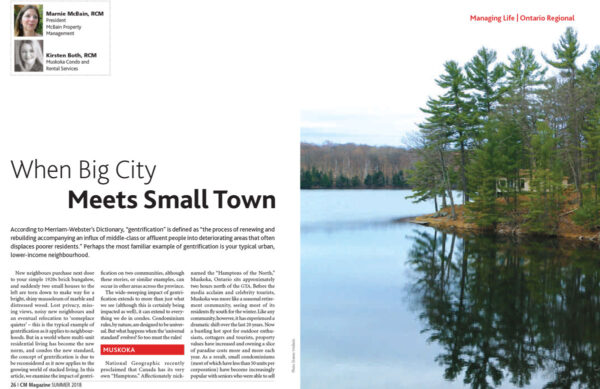MCRS Property Manager, Kirsten Both, was a recent contributor in ACMO’s Summer 2018 Edition of CM Manager.
The topic? Gentrification in condos in small towns!
Check out the article below…
When Big City Meets Small Town
 According to Merriam-Webster’s Dictionary, “gentrification” is defined as “the process of renewing and rebuilding accompanying an influx of middle-class or affluent people into deteriorating areas that often displaces poorer residents.” Perhaps the most familiar example of gentrification is your typical urban, lower-income neighbourhood.
According to Merriam-Webster’s Dictionary, “gentrification” is defined as “the process of renewing and rebuilding accompanying an influx of middle-class or affluent people into deteriorating areas that often displaces poorer residents.” Perhaps the most familiar example of gentrification is your typical urban, lower-income neighbourhood.
New neighbours purchase next door to your simple 1920s brick bungalow, and suddenly two small houses to the left are torn down to make way for a bright, shiny mausoleum of marble and distressed wood. Lost privacy, missing views, noisy new neighbours and eventual relocation to ‘someplace quieter’ – this is the typical example of gentrification as it applies to neighbourhoods. But in a world where multi-unit residential living has become the new norm, and condos the new standard, the concept of gentrification is due to be reconsidered as it now applies to the growing world of stacked living. In this article, we examine the impact of gentrification on two communities, although these stories, or similar examples, can occur in other areas across the province.
The wide-sweeping impact of gentrification extends to more than just what we see (although this is certainly being impacted as well), it can extend to everything we do in condos. Condominium rules, by nature, are designed to be universal. But what happens when the ‘universal standard’ evolves? So too must the rules!
Muskoka
National Geographic recently proclaimed that Canada has its very own “Hamptons.” Affectionately nicknamed the “Hamptons of the North,” Muskoka, Ontario sits approximately two hours north of the GTA. Before the media acclaim and celebrity tourists, Muskoka was more like a seasonal retirement community, seeing most of its residents fly south for the winter. Like any community, however, it has experienced a dramatic shift over the last 20 years. Now a bustling hot spot for outdoor enthusiasts, cottagers and tourists, property values have increased and owning a slice of paradise costs more and more each year. As a result, small condominiums (most of which have less than 50 units per corporation) have become increasingly popular with seniors who were able to sell their lakeside abodes for a premium and move into their own version of ‘carefree living.’ But as property values continue to rise and options dwindle, many city purchasers looking for a place to hang their hat when they come to Muskoka for the weekend, are also looking to condos.
At a community or social level only, residents can be divided into thirds: two-thirds of the gentrification equation are retired, lifelong northerners. One-third spills in as seasonal snowbirds who are often unwilling or unable to participate in a four-season community let alone fill a spot on a condominium board. They seem to arrive and then completely disappear again, so relationships can be difficult to build.
The three parts collide due to varying owner needs, wants, desires, values and lifestyles. Weekenders arrive with an ‘escape from the city’ attitude where they expect two days of peace and solitude, or the two-night energy of family, friends and grandchildren. The peace seekers can be interrupted by the permanent resident neighbours who expect to build a community with reciprocal benefits and the zest of louder weekenders. The hustle and bustle of grandchildren squealing with delight while parents overfill visitor parking spaces all weekend long may not be welcomed by the full-time crowd who can feel invaded from Friday evening to Sunday afternoon.
From a management perspective the usual ‘people, parking and pets’ boundaries are stretched to the maximum and sometimes snap. Consistent messaging to educate and inform all residents about the goals of the community is mandatory to helping everyone use the shared facilities/spaces fairly. Understanding is key to helping everyone get along and reducing the flurry of complaints to the management team on Monday mornings.
What about the collision of life experiences? Small towns are an environment where everyone knows everyone or knows of someone through a connection. Standi
ng at the grocery checkout can be a social event just like coffee at Tim Hortons. The city crowd is accustomed to quiet anonymity and striking up a conversation at the grocery checkout or spending half an hour chatting at the coffee shop is unusual. This gap in expectations of person-to-person connectivity can create misconceptions of hostility or discourtesy, which can then lead to tension on the common elements, or worse – at the next AGM.
Tips for Peaceful Living…
- Make relevant rules easily accessible to your residents, and frequently refer to them where possible (i.e., hours for permitted noise, guest restrictions on the common elements, etc.)
- If you have a newsletter or community information portal for your residents, try posting topics that are relevant to both demographics within your building to help them better understand one another.
- Communicate. If half your residents are tech-savvy, consider an online forum of some sort to allow them to communicate and ‘check in’ with their home away from home. If the other half have yet to make their first computer purchase, don’t forget to put out quarterly print newsletters! Whateverthepreferredstylesof communications are, do not exclude one or the other.
- In order to be successful, reach out to find common ground. This takes time and perseverance but is worth the work. Graduallyboth‘sides’ can learn much from each other if all are willing to embrace new attitudes. And what better place to evolve than under a shared roof.
The Kawarthas
Managing small buildings and townhome complexes in cottage country – with not one condominium corporation larger than 119 units in the whole area! Only five minutes to lakes, beaches,
hiking trails, cross-country ski trails, camping and best of all, little to no traffic – the average commute is only 10 minutes from one side of the city to the other… sounds like a dream job, right? Well, yes and no. Managing smaller condominiums in outlying areas has both benefits and a few downsides (many of which were discussed at last year’s Annual Condominium Conference). And gentrification in the City of Kawartha Lakes & Peterborough is one of the most recent challenges – for condominium owners, boards and managers alike.
One example that has presented recently is a direct result of the housing boom in Toronto – and as with most conflicts, this one is very financially driven. Take a local who was raised in and around the small town or city. They purchased their home in 1964 for $15,000 and lived there until the late 1990s or early 2000s. They then sold their home for $250,000 (if they were lucky). They worked their whole life and their average income over the years was never more than $50,000 per year. They may have a small pension and they purchase a condominium for $195,000. They have a little money in the bank and think they have it made – they are comfortable financially.
By the mid-to-late 2000s, their condo needs some updating, both the lobby and the interior of their own suite is looking dated. But they are on a limited income and if they aren’t foolish by putting their money into cosmetic updates, they’ll be able to afford the upcoming special assessment for the garage repair.
Enter the “big city folks’; these residents also purchased their first home in 1964 in Toronto for $15,000. They lived and worked there too. The final year of their working life, the individual from the city earned six figures. In 2014, they sold their $15,000 home for $980,000 and decided to move to a smaller centre (but still commuting distance to Toronto for the purposes of dinner and a show or to see a specialist). They purchased in the same building as our local for $200,000. Being that our city individual is now retired and away from the big city, they are bored – so they run for the board of directors – this will help keep them busy. This individual brings a lot of city experience and little small town knowledge to the table…and a lot of money in the bank. With the garage restoration looming large, a special assessment announced, our new board member brings forward, under new business, the fact that the lobby is looking dated and run down. A recommendation is put forth that the board needs to consider a lobby update and replacement of corridor carpets, and how about some lighting updates and the exercise equipment is all older and dated.
The local on the board can see the dollar signs and suggests that perhaps the cosmetic items should wait until the more urgent items are taken care of. The former city resident reasons that they need to update to maintain the value of their homes, and that because there’s already going to be a special assessment, a little more on the assessment won’t hurt anyone.
There you have it – a board divided. Why are they divided? They are similar in age, in a similar demographic; they’ve all worked hard their whole lives to get to retirement. They all love the small city or town that they now call home, and they have similar values and respect each other’s right to privacy and quiet living. The answer my friends is gentrification…
As defined at the start of this article, gentrification, at its most fundamental, is often all about the money. But to look at only the money side leaves out the human element in multi-unit shared
space communities. So how does the neutral party, namely the property manager, manage the divide that has been created? Ultimately this is not the manager’s dilemma to solve or resolve. The manager may guide, may give advice based on years of experience and yes, you may have your own opinion based on your life experiences (but you should probably keep your personal opinions out of the equation), but the Condominium Act is clear – the board of directors shall manage the affairs of the corporation. In such a case as described above, ultimately the decision to update the lobby or not, while potentially putting a financial burden on some of the owners or upsetting others because they feel their property value is being detrimentally affected by lack of cosmetic updating, is a decision of the board (and owners if they requisition a meeting to remove the member making decisions that are unfavourable to them).
By not taking sides and remaining neutral when a board becomes divided, especially when the divide is financially motivated, the manager can maintain their professionalism, their effectiveness
and will likely maintain the contract going forward.
The issues presented by gentrification are relatively new to the outlying areas and there are no magic pills or quick fixes. There is the requirement for management to use all of their people skills, all their negotiation skills, all their mediation skills and every trick in their arsenal to keep the lines of communication open, keep neighbours talking to each other and board members sitting at the table working together with respect for each other’s values and budgetary restraints.
“When Big City Meets Small Town”
Written by: Kirsten Both, RCM and Marnie McBain, RCM
Check out the complete Summer Edition of ACMO’s CM Manager Here!

